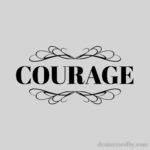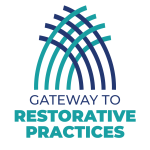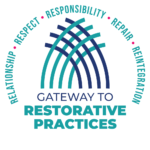
Good news we’re finally to the Part 3 Conclusion.
But first, Part 2 brief review. The participants rotated through the six Restorative Practices concepts and added content. If you were doing this activity using the campus you work at, what would scholars, staff, and visitors would See? Hear? and Feel? What would you write or say?
Facilitating Small Groups’ Content
It is my privilege to facilitate this section. I ask the spokesperson for concept one to share what scholars, staff, and visitors would See? Hear? and Feel? when on campus. Group one’s spokesperson shares their chart. Chart two awakens the group after lunch. Next, group three shares. “I know who I can talk to if I’m having a rough day.” The key words for Concept 3 are depicted in the table below.
Table 1. Concept 3: “I know who I can talk to if I’m having a rough day.”1
| See? | Hear? | Feel? |
|
|
|
The Collective Awe
When the group’s presentation is over, the participants respond in silence. I feel the silence transition to collective awe. It’s as if we are all speechless.
How do I respond to the silence and collective awe? Remember, this is unique. It rarely happens. I need to think quickly. Do I interrupt such personal and powerful reflections?
Several participants have tears in their eyes. After a significant pause, with anticipation and enthusiasm, I begin. “I WANT to work at THIS SCHOOL!” Other participants nod their heads in agreement while some just beam.
What’s Happening?
What’s going on? I wonder. This isn’t what usually happens. It could be the way the activity was engaging the brain in multiple components. Anytime I can get participants to make brain connections with content is great. Don Campbell says, “The more connections that can be made in the brain, the more integrated the experience is within memory.”2
I consider that this is a moment when educators feel personally connected to Restorative Practices. The International Institute of Restorative Practices says, “The social science of restorative practices is an emerging field of study that enables people to restore and build community in an increasingly disconnected world.”3 That would be awesome!
Collective Awe Raises Curiosity
As a 12th year Restorative Practices in Schools trainer and consultant with the same TK-12 school district, I’m in awe as a veteran trainer and consultant alongside these participants. I’m curious about how the collective awe came about.
Typically, we’re so busy at work we don’t even chit-chat with our colleagues. Maybe the educators felt heard by the trainers and their colleagues. Rachel Naomi Remen, M.D. says, “I suspect that the most basic and powerful way to connect to another person is to listen. Just Listen. Perhaps the important thing we ever give each other is our attention.”4, p. 29.

Courage
Perchance there’s united courage felt by the educators. And me. Courage to build healthy relationships through trust and make a difference in the lives of future adults. Courage to stay in the education field that’s been especially challenging since Covid 19. Courage to implement restorative practices at school. I’m reminded of how American poet Maya Angelou defines courage. “Courage is the most important of all the virtues, because without courage you can’t practice any other virtue consistently.”5
Interconnectedness, Worth, and Well-Being
Feasibly, the educators felt empowered with the realization that endless positive results can impact scholars, staff, and themselves personally. Authors Katherine Evans and Dorothy Vaanderling authors of Restorative Justice in Education… say, “Being proactive in creating school climates where the well-being of every member is sought requires that restorative justice education facilitators return over and over to the core beliefs of interconnectedness, worth, and the well-being of all participants.”6, p. 108
My colleagues and I may never know the reasons for the collective awe; however, I suspect a few powerful words might be behind it: Interconnectedness; Worth; and Well-being.
Sources
- 2023. A Day in the Life of a Student who is Part of a Restorative Community. Jessica “Jessie” Tena, Dr. Michelle Ferrer, & The RJP Team at SDUSD. https://lkwbetterworld.files.wordpress.com/2023/12/rjp-sdusd_day-in-the-life.png
- https://allauthor.com/quotes/author/don-campbell/
- 2011. Building Community, Building Peace. Josh Wachtel, October 17. https://www.iirp.edu/news/building-community-building-peace
- 2020. “Just Listen.” Cultivating Restorative School Communities Restorative Circles – Solano County Office of Education: Tier 1 MTSS. Kerri Berkowitz.https://www.readkong.com/page/cultivating-restorative-school-communities-restorative-4687488
- Maya Angelou. No date. https://www.brainyquote.com/quotes/maya_angelou_120859
- Restorative Justice in Education: Fostering Responsibility. Healing, and Hope in Schools. NY: Good Books, 2016, 2022.
- Images: A Day in the Life of a [2025 A Kim Eddy Design]; courage title [denisemcolby.com_courage-word-year-highlights] Used with permission April 2025.

